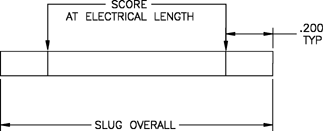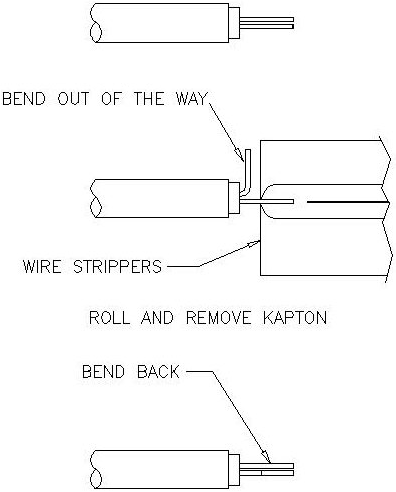Stripping
Procedures for Bulk WIRELINE
(Hybrids & Couplers)
STEP 1:
PREPARING THE SLUG LENGTH
Using a sharp blade or
saw:
Allowing for required jacket length (calculated
based on electrical frequency) and typical lead length of 0.200 inches on
each end, cut the 5 foot bulk length into individual "slugs" for
stripping.
STEP 2: REMOVING THE OUTER
JACKET
Using a sharp blade:
Take an
individual "slug", center the actual jacket length and then roll the
material under the blade creating a "score" which penetrates the outer
jacket (see Figure 1). Be careful not to cut deeply into the Tefzel™ (Du
Pont) dielectric.
FIGURE 1
Using the specified thermal strippers:
Gripping the WIRELINE body with your fingers and the scored
section with a set of pliers, crack the outer jacket along the score mark.
Set the dial on the strippers to the midpoint setting (5-5
1/2 for Meisei, 50 - 55 for American Beauty).
Hold the
WIRELINE body with one hand, (for short lengths a glove will prevent
burns), and grasp the scored end with the thermal strippers.
As the outer jacket expands due to the heat from the strippers, it
will slide off the Tefzel™ (Du Pont) quite easily.
STEP 3:
TEMPERATURE CYCLING (OPTIONAL)
The electrical
performance of WIRELINE is tightly controlled and the manufacturing
process used to accomplish this produces stresses in the core which tend
to equalize by cold flow after the WIRELINE is cut to length. It is
therefore advantageous to stress relief or precondition WIRELINE per the
following table:
| STEP |
TEMPERATURE |
TIME |
| 1 | Room Temperature (25°C) to -65°C | 15 minutes |
| 2 | -65°C dwell | 1 hour |
| 3 | -65°C to + 140°C | 30 minutes |
| 4 | 140°C dwell | 1 hour |
| 5 | 140°C to Room Temperature (25°C) | 15 minutes |
Repeat this cycle 2 times for a total of 3 temperature cycles.
STEP 4: REMOVING THE TEFZEL DIELECTRIC
Using the thermal tweezers:
Place the Tefzel™ (Du Pont) portion of the WIRELINE through the blades of the thermal tweezers up to the outer jacket, as shown in Figure 2 on the next page.
Squeezing the tweezers lightly, roll the WIRELINE to melt through the Tefzel™ (Du Pont) as close as possible to the jacket.
The gap on the closed tweezers must be adjusted so that the inner conductors are not scored.
Once the Tefzel™ (Du Pont) has been melted through to the inner conductors, remove by firmly pulling while holding the tweezers closed.
Release the tweezers between operations. This is necessary to maintain the proper temperature and prevent melting of the Kapton™ (Du Pont) insulator on the inner conductor. (Use of gloves is suggested while holding the WIRELINE body.)
FIGURE 2

STEP 5: REMOVING THE KAPTON INSULATION
Using mechanical wire strippers:
Bend the insulated wire lead 90° as shown in Figure 3, to allow room for removing the Kapton™ (Du Pont) tape.
Place the insulated wire lead into the C.K #3756 modified (grind the face back to the desired fixed strip length) strippers (AWG-30 for HC, AWG-26 for JC). Push the wire as far in as possible without damaging the un-insulated wire.
Rotate the wire both ways while gripping the wire strippers. The purpose here is to cut through and loosen the Kapton™ (Du Pont).
While holding the wire strippers shut, remove the Kapton™ (Du Pont) by pulling the wire away from the wire strippers.
Bend the un-insulated wire back to its original position. This wire should only be bent and unbent once in the removal operation as excess bending will reduce mechanical integrity of the wire.
FIGURE 3

STEP 6: CLEANING THE FINISHED WIRELINE (OPTIONAL)
All WIRELINE pieces may be suspended in a vapor degreaser for up to 3 minutes to remove any foreign matter. Wiping pieces clean with alcohol or acetone is also acceptable, but WIRELINE SHOULD NOT BE IMMERSED IN ANY SOLUTION AT ANY TIME.
ADDITIONAL INFORMATION
As an alternative to your manual in-house stripping of bulk WIRELINE, pre-finished units can be obtained from Sage which are stripped via a laser processing technique. This value added process allows you to receive units with precision cuts and dimensioning on the Tefzel™ (Du Pont) dielectric and Kapton™ (Du Pont) insulator, which are ready to simply solder into your application. We would be happy to address any questions and provide a quotation upon request.
Electrical, mechanical and environmental parameters, as well as application notes addressing mounting considerations, component functions and commonly asked questions are detailed in our comprehensive WIRELINE® and WIREPAC© Design Guide brochure. Exact jacket length calculations can be obtained by using the formula on page 2 of the brochure or by accessing the Agilent (HP) Libra J-OMEGA simulation software.
The Design Guide, as well as a handy slide rule calculator, are available upon request from your area field sales representative.
WIRELINE and WIREPAC are registered trademarks of Sage Laboratories, Inc.
Tefzel is a registered trademark of Du Pont.
Kapton is a registered trademark of Du Pont.
SUGGESTED TOOLS
In order to assist you in obtaining the tools necessary to perform the operations described herein, we are pleased to offer the following list of suggested tools and their vendors.
TEFZEL REMOVAL:
| Manufacturer | Suggested Tools |
| Assembly Technologies International, Inc. (American Beauty Line) |
1. Power Control Unit #105-A3T 2. Tweezer Type Wire Strippers #10517 |
| Meisei Corporation | 1. Model M-10 Power Supply 2. #4C Hot Tweezers |
KAPTON REMOVAL:
| Manufacturer | Suggested Tools |
| Carl Kämmerling GmbH & Co. (C.K) |
1. Nickless Wire Strippers
A. For HC WIRELINE: |
| Assembly Technologies International, Inc. (American Beauty Line) |
1. Tweezer Type Strippers #105131 |
MAINTAIN PROPER VENTILATION AT ALL TIMES
AS MATERIAL FUMES CAN BE TOXIC.